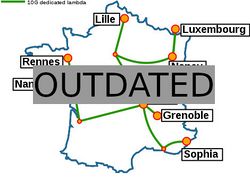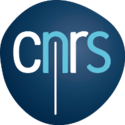Grid5000:Home: Difference between revisions
No edit summary |
No edit summary |
||
| (4 intermediate revisions by 3 users not shown) | |||
| Line 7: | Line 7: | ||
Key features: | Key features: | ||
* provides '''access to a large amount of resources''': | * provides '''access to a large amount of resources''': 12000 cores, 800 compute-nodes grouped in homogeneous clusters, and featuring various technologies: GPU, SSD, NVMe, 10G and 25G Ethernet, Infiniband, Omni-Path | ||
* '''highly reconfigurable and controllable''': researchers can experiment with a fully customized software stack thanks to bare-metal deployment features, and can isolate their experiment at the networking layer | * '''highly reconfigurable and controllable''': researchers can experiment with a fully customized software stack thanks to bare-metal deployment features, and can isolate their experiment at the networking layer | ||
* '''advanced monitoring and measurement features for traces collection of networking and power consumption''', providing a deep understanding of experiments | * '''advanced monitoring and measurement features for traces collection of networking and power consumption''', providing a deep understanding of experiments | ||
| Line 82: | Line 82: | ||
===Regional councils=== | ===Regional councils=== | ||
Aquitaine<br/> | Aquitaine<br/> | ||
Auvergne-Rhône-Alpes<br/> | |||
Bretagne<br/> | Bretagne<br/> | ||
Champagne-Ardenne<br/> | Champagne-Ardenne<br/> | ||
Provence Alpes Côte d'Azur<br/> | Provence Alpes Côte d'Azur<br/> | ||
Hauts de France<br/> | |||
Lorraine<br/> | Lorraine<br/> | ||
|} | |} | ||
Revision as of 18:54, 13 December 2018
|
Grid'5000 is a large-scale and versatile testbed for experiment-driven research in all areas of computer science, with a focus on parallel and distributed computing including Cloud, HPC and Big Data. Key features:
Older documents:
|
Random pick of publications
Five random publications that benefited from Grid'5000 (at least 2517 overall):
- Anna Mossolova, Kamel Smaïli. The only chance to understand: machine translation of the severely endangered low-resource languages of Eurasia. The Fifth Workshop on Technologies for Machine Translation of Low-Resource Languages (LoResMT), COLING 2022, Oct 2022, Gyeongju, South Korea. hal-03774644 view on HAL pdf
- Hubert Nourtel, Pierre Champion, Denis Jouvet, Anthony Larcher, Marie Tahon. Analyse de l'anonymisation du locuteur sur de la parole émotionnelle. JEP 2022 - Journées d'Études sur la Parole, Jun 2022, Île de Noirmoutier, France. hal-03636737 view on HAL pdf
- Ajinkya Kulkarni, Vincent Colotte, Denis Jouvet. Analysis of expressivity transfer in non-autoregressive end-to-end multispeaker TTS systems. INTERSPEECH 2022, Sep 2022, Incheon, South Korea. hal-03832870 view on HAL pdf
- Bastien Confais, Gustavo Rostirolla, Benoît Parrein, Jérôme Lacan, François Marques. Mutida: A Rights Management Protocol for Distributed Storage Systems Without Fully Trusted Nodes. Transactions on Large-Scale Data- and Knowledge-Centered Systems, 13470, Springer Berlin Heidelberg, pp.1-34, 2022, Lecture Notes in Computer Science, 10.1007/978-3-662-66146-8_1. hal-03822471 view on HAL pdf
- Nathalie Azevedo Carvalho. Un modèle informatique biologiquement réaliste des oscillations neuronales pathologiques observées dans la maladie de Parkinson. Informatique cs. Université de Lorraine, 2022. Français. NNT : 2022LORR0077. tel-03765515 view on HAL pdf
Latest news
Failed to load RSS feed from https://www.grid5000.fr/mediawiki/index.php?title=News&action=feed&feed=atom: Error parsing XML for RSS
Grid'5000 sites
Current funding
As from June 2008, Inria is the main contributor to Grid'5000 funding.
INRIA |
CNRS |
UniversitiesUniversité Grenoble Alpes, Grenoble INP |
Regional councilsAquitaine |


